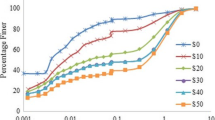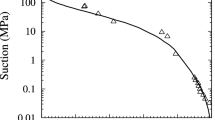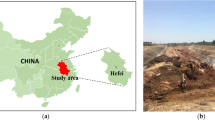Abstract
It has been long recognised that some of the fundamental and engineering properties of soils exhibit a certain degree of anisotropy that eventually dictates their directional geoengineering behaviours. Consideration of the importance of the volume change behaviour of soils during shrinkage and a critical review of the literature suggests scopes for further research for the development of a better understanding of the anisotropy in volume change encountered during soil shrinkage. In this paper, anisotropy in volumetric shrinkage behaviour of soil is depicted with the theory of geometry factor and shrinkage strains. A systematic investigation and analysis on the evolution of geometry factors and shrinkage strains of several geomaterial samples during evaporative dewatering is reported herein. A theoretical framework for evaluating shrinkage geometry factors of a cylindrical soil specimen undergoing volume change during progressive moisture loss is described in this paper. Furthermore, based on experimental and literature data, shrinkage geometry factors of several specimens differing in terms of gradational properties, specimen size, evaporative boundary condition and pore fluid salinity are evaluated and discussed in detail in accordance with the theoretical framework. Linkages between shrinkage process, shrinkages strains and geometry factor are also analysed to underpin the usage of geometry factor and shrinkage strains to characterise anisotropy during soil shrinkage.








Similar content being viewed by others
Abbreviations
- α, β, n, m :
-
Parameters in the model by Kim et al. [19]
- εd/εv, RDS:
-
Relative diametrical strain
- ε d :
-
Diametrical strain
- Δd :
-
Change in specimen diameter
- Δh :
-
Change in specimen height
- ε l :
-
Longitudinal strain
- εl/εv, RLS:
-
Relative longitudinal strain
- ε v :
-
Volumetric strain
- A,p :
-
Parameters in the model by Sabnis et al. [43]
- d :
-
Specimen diameter at a given time
- d 0 :
-
Initial specimen diameter
- GMC:
-
Gravimetric moisture content
- h :
-
Specimen height at a given time
- h 0 :
-
Initial specimen height
- NMCOMC :
-
Normalised moisture content with respect to optimum moisture content
- POB:
-
Dredged mud sample from port of Brisbane reclamation site
- r s :
-
Static geometry factor
- \( r_{\text{s}}^{\prime } \) :
-
Representative static geometry factor
- r sd :
-
Static geometry factor corresponding to diametrical shrinkage
- r sl :
-
Static geometry factor corresponding to vertical shrinkage
- S s :
-
Shrinkage strain
- SLGE :
-
Shrinkage limit as defined in geotechnical engineering
- SSCC:
-
Soil shrinkage characteristic curve
- V :
-
Specimen volume at a given time
- V 0 :
-
Initial specimen volume
- w :
-
Gravimetric moisture content of the specimen at a given time
- w 0 :
-
Gravimetric moisture content of the specimen initially
References
Anandarajah A (2000) On influence of fabric anisotropy on the stress–strain behavior of clays. Comput Geotech 27(1):1–17
Baer JU, Anderson SH (1997) Landscape effects on desiccation cracking in an Aqualf. Soil Sci Soc Am J 61(5):1497–1502
Bani Hashem E, Houston SL (2015) Volume change consideration in determining unsaturated soil properties for geotechnical applications. Int J Geomech 16(6):D4015003. https://doi.org/10.1061/(ASCE)GM.1943-5622.0000586
Beck-Broichsitter S, Gerke HH, Horn R (2018) Shrinkage characteristics of boulder marl as sustainable mineral liner material for landfill capping systems. Sustainability 10(11):4025
Berney IV, Ernest S, Hodo WD, Peters JF, Myers TE, Olsen RS, Sharp MK (2008) Assessment of the effectiveness of clay soil covers as engineered barriers in waste disposal facilities with emphasis on modelling cracking behaviour. Report No. (ERDC-TR-08-7). Nuclear regulatory commission Washington DC, USA
Brake BT, van Der Ploeg MJ, De Rooij GH (2013) Water storage change estimation from in situ shrinkage measurements of clay soils. Hydrol Earth Syst Sci 17(5):1933–1949
Bronswijk JJB (1986) Evaporation and cracking of a heavy clay soil. Report 14, Inst. Land and Water Management Research, Wageningen, Netherlands
Bronswijk JJB (1990) Shrinkage geometry of a heavy clay soil at various stresses. Soil Sci Soc Am J 54(5):1500–1502
Chertkov VY (2005) The shrinkage geometry factor of a soil layer. Soil Sci Soc Am J 69(6):1671–1683
Chertkov VY, Ravina I, Zadoenko V (2004) An approach for estimating the shrinkage geometry factor at a moisture content. Soil Sci Soc Am J 68(6):1807–1817
Clennell MB, Dewhurst DN, Brown KM, Westbrook GK (1999) Permeability anisotropy of consolidated clays. Geol Soc Lond Spec Publ 158(1):79–96
Fisher BL, Doumet R (2017) Remediation solutions for buildings affected by shrinkage or swelling of unsaturated clays. In: Proceeding of the 2nd Pan American conference on unsaturated soils, GSP303:209-224, Dallas, USA
Garnier P, Perrier E, Jaramillo RA, Baveye P (1997) Numerical model of 3-dimensional anisotropic deformation and 1-dimensional water flow in swelling soils. Soil Sci 162(6):410–420
Garnier P, Rieu M, Boivin P, Vauclin M, Baveye P (1997) Determining the hydraulic properties of a swelling soil from a transient evaporation experiment. Soil Sci Soc Am J 61(6):1555–1563
Gebhardt S, Fleige H, Horn R (2012) Anisotropic shrinkage of mineral and organic soils and its impact on soil hydraulic properties. Soil Tillage Res 125:96–104
Gomboš M, Tall A, Kandra B, Balejčíková L, Pavelková D (2018) Geometric factor as the characteristics of the three-dimensional process of volume changes of heavy soils. Environments 5(4):45
Jovičić V, Coop MP (1998) The measurement of stiffness anisotropy in clays with bender element tests in the triaxial apparatus. Geotech Test J 21(1):3–10
Kang X, Kang GC, Bate B (2014) Measurement of stiffness anisotropy in kaolinite using bender element tests in a floating wall consolidometer. Geotech Test J 37(5):869–883
Kim DJ, Vereecken H, Feyen J, Boels D, Bronswijk JJB (1992) On the characterization of properties of an unripe marine clay soil: I. Shrinkage processes of an unripe marine clay soil in relation to physical ripening. Soil Sci 153(6):471–481
Kirkgard MM, Lade PV (1993) Anisotropic three-dimensional behaviour of a normally consolidated clay. Can Geotech J 30(5):848–858
Li JH, Zhang LM, Wang Y, Fredlund DG (2009) Permeability tensor and representative elementary volume of saturated cracked soil. Can Geotech J 46(8):928–942
Ling HI, Tatsuoka F (1994) Performance of anisotropic geosynthetic-reinforced cohesive soil mass. J Geotech Eng 120(7):1166–1184
Lings ML, Pennington DS, Nash DFT (2000) Anisotropic stiffness parameters and their measurement in a stiff natural clay. Géotechnique 50(2):109–125
Lo KY, Morin JP (1972) Strength anisotropy and time effects of two sensitive clays. Can Geotech J 9(3):261–277
Marinho FAM (2017) Fundamentals of soil shrinkage. In: Proceedings of the 2nd Pan American conference on unsaturated soils. GSP300:198-222. Dallas, USA
Mayne PW (1985) Stress anisotropy effects on clay strength. J Geotech Eng 111(3):356–366
Menzies BK, Mailey LK (1976) Some measurements of strength anisotropy in soft clays using diamond-shaped shear vanes. Geotechnique 26(3):535–538
Michalowski RL, Cermák J (2002) Strength anisotropy of fibre-reinforced sand. Comput Geotech 29(4):279–299
Mishra PN, Bore T, Scheuermann A, Li L (2020) Characterisation of pore fluid salinity dependent evaporative dewatering of kaolin using dielectric spectroscopy. Rock Mech Geotech Eng 12(1):112–125
Mishra PN, Scheuermann A, Li L (2018) Significance of corrections and impact of saline pore fluid on kaolin. J Mater Civ Eng. https://doi.org/10.1061/(asce)mt.1943-5533.0002458
Mishra PN, Bore T, Scheuermann A, Li L (2018b) An integrated approach for capturing dielectric response and volume change behaviour of dredged material from port of Brisbane. In: Proceedings of the 7th international conference on unsaturated soils (UNSAT-2018), Hong Kong
Mishra PN, Scheuermann A, Bore T, Li L (2018) Salinity effects on soil shrinkage characteristic curves of fine grained geomaterials. J Rock Mech Geotech Eng 11(1):181–191
Mualem Y (1984) Anisotropy of unsaturated soils 1. Soil Sci Soc Am J 48(3):505–509
Ng CWW, Yung SY (2008) Determination of the anisotropic shear stiffness of an unsaturated decomposed soil. Géotechnique 58(1):23–35
Nishimura S, Minh NA, Jardine RJ (2007) Shear strength anisotropy of natural London clay. Géotechnique 57(1):49–62
Noack M, Wagner N, Wuttke F, Witt KJ (2013) Determination of coupled structural changes in shrinking clays with high frequency electromagnetic minimal invasive techniques in real time. In: Proceedings of the, 10th international conference on electromagnetic wave interaction with water and moist substances (ISEMA 2013). Weimar, Germany, pp 231–241
Oda M (1981) Anisotropic strength of cohesionless sands. J Geotech Eng 107(9):1219–1231
O’Donovan J, O’Sullivan C, Marketos G, Wood DM (2015) Anisotropic stress and shear wave velocity: DEM studies of a crystalline granular material. Géotech Lett 5(3):224–230
Oleszczuk R, Bohne K, Szatylowicz J, Brandyk T, Gnatowski T (2003) Influence of load on shrinkage behavior of peat soils. J Plant Nutr Soil Sci 166(2):220–224
Piriyakul K (2006) Anisotropic stress-strain behaviour of Belgian Boom clay in the small strain region. Doctoral dissertation, Ghent University, Belgium
Richardson DN, Stephenson RW, Molloy D (1987) Soil-shrinkage induced structural failure. J Perform Constr Facil 1(4):219–228
Rijniersce K (1983) A simulation model for physical soil ripening in the Ijsselmeer polders. In: Proceedings of the Overdruk uit: polders of the world: papers international symposium. Lelystad, Netherlands, pp 407–417
Sabnis A, Abdallah I, Nazarian S, Puppala A (2010) Development of shrinkage model for clays based on moisture variation. In: Proceedings of the GeoShanghai international conference. Shanghai, China, pp 166–172
Saleh-Mbemba F, Aubertin M, Mbonimpa M, Li L (2016) Experimental characterization of the shrinkage and water retention behaviour of tailings from hard rock mines. Geotech Geol Eng 34(1):251–266
Santamarina JC, Cascante G (1996) Stress anisotropy and wave propagation: a micromechanical view. Can Geotech J 33(5):770–782
Shire T, O’Sullivan C, Barreto D, Gaudray G (2013) Quantifying stress-induced anisotropy using inter-void constrictions. Géotechnique 63(1):85–91
Stewart RD, Rupp DE, Najm MR, Selker JS (2016) A unified model for soil shrinkage, subsidence, and cracking. Vadose Zone J 15(3):1–15
Su SF, Liao LH (1999) Effect of strength anisotropy on undrained slope stability in clay. Geotechnique 49(2):215–230
Towner GD (1986) Anisotropic shrinkage of clay cores, and the interpretation of field observations of vertical soil movement. J Soil Sci 37(3):363–371
Toyota H, Takada S, Susami A (2018) Mechanical properties of saturated and unsaturated cohesive soils with stress-induced anisotropy. Géotechnique 68(10):883–892
Tran DT, Fredlund DG, Chan DH (2015) Improvements to the calculation of actual evaporation from bare soil surfaces. Can Geotech J 53(1):118–133
Widomski MK, Stępniewski W, Horn R, Bieganowski A, Gazda L, Franus M, Pawłowska M (2015) Shrink-swell potential, hydraulic conductivity and geotechnical properties of clay materials for landfill liner construction. Int Agrophys 29(3):365–375
Witt KJ, Brauns J (1983) Permeability-anisotropy due to particle shape. J Geotech Eng 109(9):1181–1187
Zdravković L, Potts DM, Hight DW (2002) The effect of strength anisotropy on the behaviour of embankments on soft ground. Géotechnique 52(6):447–457
Zhao J, Guo N (2015) The interplay between anisotropy and strain localisation in granular soils: a multiscale insight. Géotechnique 65(8):642–656
Zhao NF, Ye WM, Chen B, Chen YG, Cui YJ (2019) Modeling of the swelling–shrinkage behavior of expansive clays during wetting–drying cycles. Acta Geotech 14(5):1325–1335
Acknowledgements
This work was funded by scholarship supports through ‘Australian Government Research Training Program Scholarship’ (Formerly ‘International Postgraduate Research Scholarship’), UQ Centennial Scholarship (The University of Queensland) and Top up scholarship (School of Civil Engineering, The University of Queensland) awarded to Mr. P.N. Mishra. The support through the Port of Brisbane/UQ research venture is gratefully acknowledged. We also thank the anonymous reviewers for their time and suggestions to improve the manuscript.
Author information
Authors and Affiliations
Corresponding author
Additional information
Publisher's Note
Springer Nature remains neutral with regard to jurisdictional claims in published maps and institutional affiliations.
Rights and permissions
About this article
Cite this article
Mishra, P.N., Zhang, Y., Bhuyan, M.H. et al. Anisotropy in volume change behaviour of soils during shrinkage. Acta Geotech. 15, 3399–3414 (2020). https://doi.org/10.1007/s11440-020-01015-6
Received:
Accepted:
Published:
Issue Date:
DOI: https://doi.org/10.1007/s11440-020-01015-6




